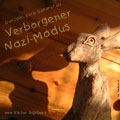Das Spiel, zuvor bekannt als Verborgener Nazi-Modus — 20 of 32
Victor Gijsbers, ins Deutsche übertragen von ifwizz
Chapter - Türen
[Türen werden in Beschreibungen erwähnt, waren aber beim Untersuchen oder aufessen nicht vorhanden:]
The shop-door is in In the Grocery. It is scenery. It is female. The printed name is "Ladentür". Understand "ladentuer" and "tuer" as shop-door. Instead of examining the shop-door: say "Eine gläserne Metallrahmen-Mehrzwecktür.". Instead of doing anything other than examining with the shop-door: say "Diese gläserne Metallrahmen-Mehrzwecktür hat außer ihrer Erwähnung keine weitere Bedeutung.".
The hall-door is in the Hall. It is scenery. It is female. The printed name is "Haustür". Understand "haustuer" as hall-door. Instead of examining the hall-door: say "Eine massive hölzerne Mehrzwecktür mit Guckfenster.". Instead of doing anything other than examining with the hall-door: say "Diese massive hölzerne Mehrzwecktür mit Guckfenster hat außer ihrer Erwähnung keine weitere Bedeutung.".
The piano-door is in the Piano room. It is scenery. It is female. The printed name is "Tür zum Klavierzimmer". Understand "tuer" as piano-door. Instead of examining the piano-door: say "Schlichte, weiß gestrichene Zimmertüren.". Instead of doing anything other than examining with the piano-door: say "Diese schlichten, weiß gestrichenen Zimmertüren haben außer ihrer Erwähnung keine weitere Bedeutung.".
The study-door is in the Study. It is scenery. It is female. The printed name is "Tür zum Studierzimmer". Understand "tuer" as study-door. Instead of examining the study-door: say "Eine schlichte, weiß gestrichene Zimmertür.". Instead of doing anything other than examining with the study-door: say "Diese schlichte, weiß gestrichene Zimmertür hat außer ihrer Erwähnung keine weitere Bedeutung.".
